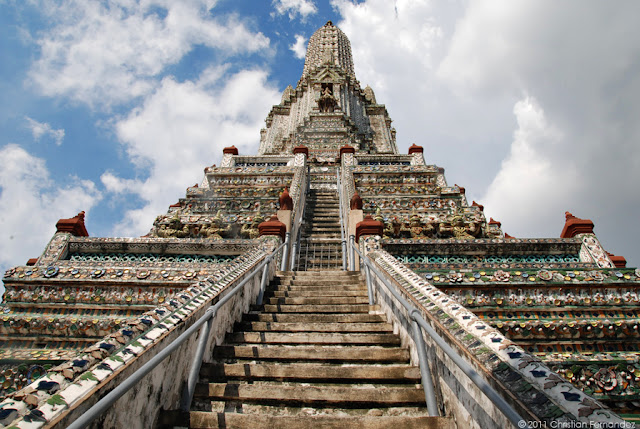The religion of Thailand, which is Theravada Buddhism with an obvious influence of Hinduism is really quite something to see in practice. Watching a devotee in prayer is at times almost like watching a dramatic performance art: prayers involve graceful and measured movements, often using lotus flowers, incenses, thick garlands, goldleafs, giant candles, and colorful ribbons. Large elements of animistic thinking is also retained. Spirit houses dot almost every corner of the city, always containing fresh offerings of flowers and fruit, and around significant temples there are rows and rows of vendors selling Buddhist amulets, which apparently are quite a serious business here. The beauty of this religion is reflected into the numerous exotic temples that define Thailand’s landscape. Though I can’t help but wonder what the Buddha, who of all things promotes detachment from mundane desires, have to do with all those golden statues and luxurious temple complexes.
Wat Ratchabophit
I was caught by surprise when I arrived in this little-known temple in the Old City. This must be the most beautiful of all the temples I have visited in Thailand. The building structure is unique in that it is circular and the decorations look more Western than Thai. The outer walls are in-laid with ornate tiles rather than plainly painted white as with most other temples. The design, although elaborate, feels quaint and homey. It’s a bit off the tourist-track and I came in early morning, so I was fortunate to suck in all its glorious beauty all by myself.
Wat Suthat
Also known as the temple of immeasurable charm. There are lots of big stuff in here: the vast marble-floored temple grounds, the huge main temple, ginormous Buddha inside, and then there’s the Giant Swing structure towering just in front of the temple complex. The ticket stub says that it is “the only temple in Thailand where you can enjoy your visit happily in a nice peaceful atmosphere”. True enough, even though there were a couple of other people there when I came in, the place was as quiet as a library.
The Golden Mount
A steep conical hill with spiraling stairs. It took me a lot of guts (thanks to my fear of heights) and lots of bottled water to reach the top, once the highest point in the city. Thankfully there is a canteen halfway the climb where I could replenish my water supply and get some needed calories. My efforts were well-paid with a spectacular albeit knee-shivering view of the city. At the very top is a huge golden chedi beside which hangs strings of paper money and an altar to which pilgrims pray. There is also an indoor shrine and a souvenir shop where I bought a couple of Buddhist string bracelets for folks at home.
A replica of the Golden Mount at the first steps of the stairway
The seemingly endless climb
A quaint canteen half-way thought the climb

A view of Bangkok
Loha Prasat
The defining feature of this temple is its metal spires, hence the name (which is Tibetan for “metal temple”). The floor plan is designed in the form of concentric squares evoking the shape of a mandala. It is acoustically efficient too. Despite the building construction going on outside, the temple interiors were quite silent. Many visitors go directly to the rooftop to get up close and personal with the metal spires, but it is worthwhile to explore each of the maze-like floors too, which can be meditative. I love this place. It’s just so relaxing and calming.
The metal spires of Loha Prasat
The serene interiors of the temple
Wat Arun
The temple I was most excited to see. I went to Wat Arun the wrong way. Normally it can be easily reached via a ferry crossing from Rattanakosin, but I went there by foot instead in the Thonburi area (the other side of the river). It was quite a long and boring walk under the arid tropical sun, but it was kind of surreal seeing exotic-looking prangs towering over modern, suburban streets. The wat is a spectacular sight to behold whether from afar or looked closely. The prangs are decorated with bits and pieces of Chinese porcelain which were recovered from the Chao Phraya river from sunken barges, and what an unbelievable piece of work it is. It is said that the temple looks more stunning at sunset, but I unfortunately didn’t get to see that since I was busy frolicking in the downtown area during those times.
Approaching Wat Arun from Thonburi area
Wat Arun decorations made from broken porcelain
Wat Traimit
Here in Chinatown can be found the world’s largest solid gold Buddha. I could almost imagine the dollar-signs over my eyes when I saw it. It also has a very interesting story. The relic dates back to the 13th century and was once covered with plaster to hide its value from Burmese conquerors. After a few centuries the camouflage had been forgotten. Its true nature was only discovered fairly recently (1957) when the statue fell and some of the plaster chipped off.
The solid gold Buddha
The bird and the bell
Tucked in the middle of Chinatown, the red, white and gold temple is remarkable to look at. But there is just something eerie and mysterious about this temple. Among the things I found here are a monkey skull, a spider effigy and a pair of huge crocodiles in the temple grounds. The place was silent except for the occasional flapping of a bird’s wings which just adds to the creepy-vibe. I had the place on my own when I came so I was able to have my little me-time with the Buddha.
The prang looms over the mysterious temple
Nagas
Skull and spider
Monks' robes flutter on the wind
A garland for the Buddha
A resident of the temple
Basbasan Nawa!
































 Posted in:
Posted in: 










0 comments:
Post a Comment